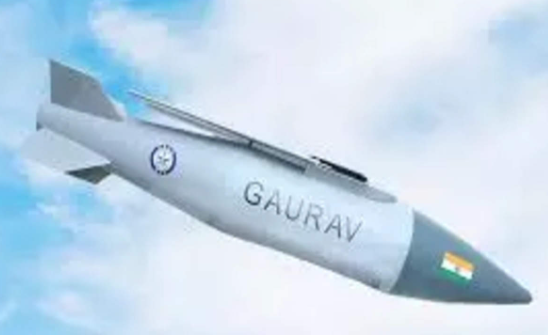DRDO Successfully Tests Long-Range Glide Bomb ‘Gaurav’
On August 13, 2024, the Defence Research and Development Organisation (DRDO) of India successfully carried out the first flight test of a long-range glide bomb named Gaurav. This test, conducted using a Su-30 MK-I fighter jet from the Indian Air Force, is a significant step forward in India’s efforts to develop its own advanced defence technologies.
What is Gaurav?
Gaurav is a cutting-edge air-launched glide bomb that weighs 1,000 kg. It is designed to hit targets from a long distance and is equipped with a sophisticated navigation system that uses multiple guidance methods to ensure it strikes with high accuracy.
Development and Design
The Gaurav bomb was developed by the Research Centre Imarat in Hyderabad. This project is a key example of India’s focus on achieving self-reliance in defence technology, reducing the need to rely on military equipment from other countries.
Flight Test Details
The first test flight took place off the coast of Odisha, where the glide bomb successfully hit a target on Long Wheeler’s Island. To gather detailed information during the test, advanced telemetry and electro-optical tracking systems were used.
Involvement of Key Partners
The project saw collaboration from private companies, including Adani Defence and Bharat Forge, which acted as Development cum Production Partners. Their involvement highlights the growing role of the private sector in India’s defence industry. Defence Minister Rajnath Singh praised this successful test, calling it a crucial milestone in enhancing India’s self-sufficiency in defence technologies. The success of this test boosts the capabilities of the Indian Armed Forces and demonstrates the country’s progress in military technology.
What is long-range glide bomb?
Long-range glide bombs like Gaurav can travel over 110 kilometers without needing propulsion. They are guided by GPS to ensure they hit their targets accurately and are designed to avoid detection by radar. Other similar bombs include the GBU-39/B, which has similar long-range capabilities, and the UK’s Paveway IV, which can be adapted for different missions. The JDAM (Joint Direct Attack Munition) is another example, turning regular free-fall bombs into precision-guided weapons. Such technologies were first developed by Israel in the 1980s. These bombs are typically launched from strategic bombers or fighter jets and are designed to be hard to detect, increasing their effectiveness in military operations.
Facts About DRDO
- The Defence Research and Development Organisation (DRDO) was created in 1958.
- It works under the Ministry of Defence and has more than 50 laboratories.
- DRDO’s first big project was developing the Ajanta missile.
- It is known for its work on the Tejas fighter aircraft and the Akash missile system.
- It plays an important role in India’s National Missile Development Programme.
- DRDO’s main aim is to make India more self-reliant in defence technology and systems.
Month: Current Affairs - August, 2024
Category: Defence Current Affairs






